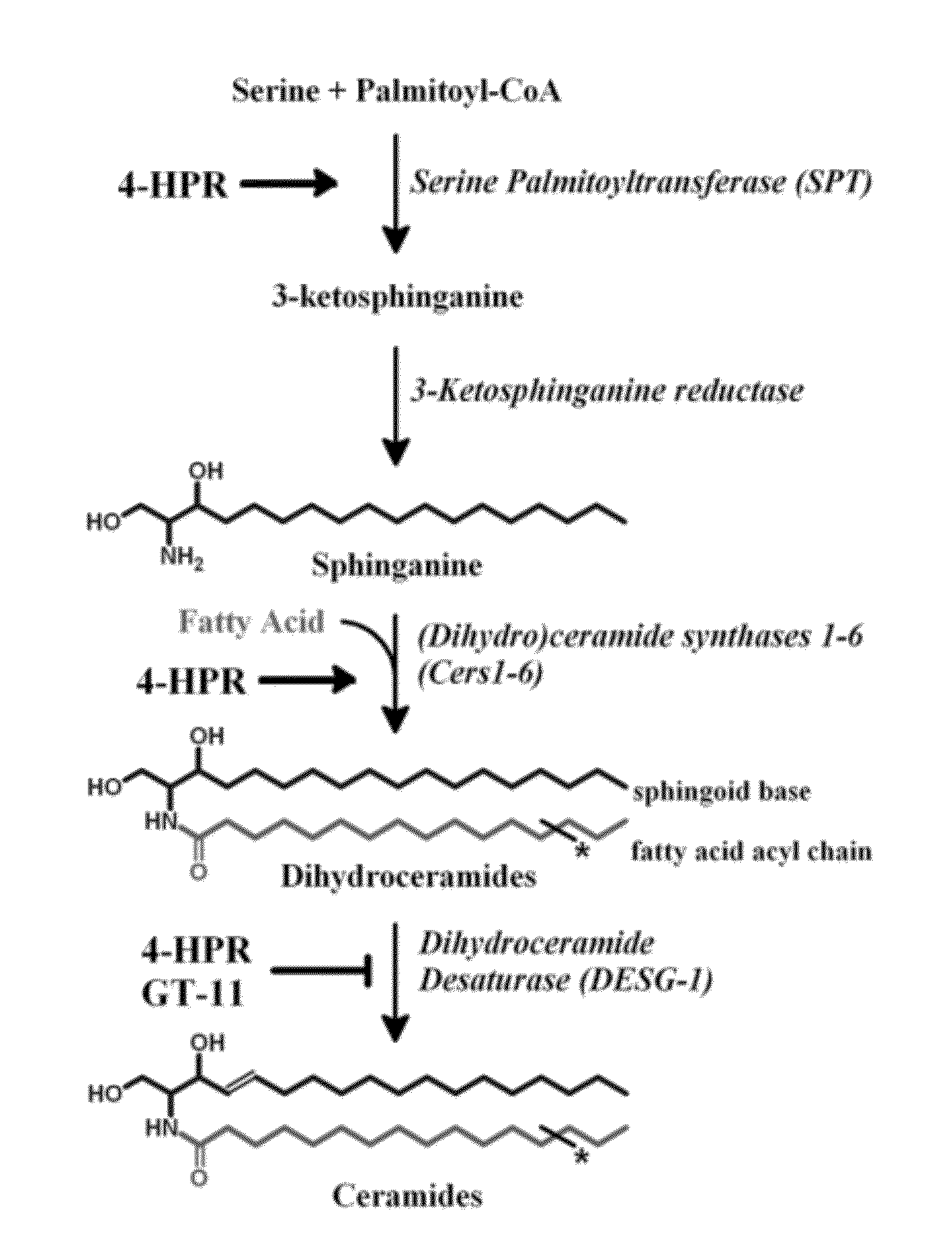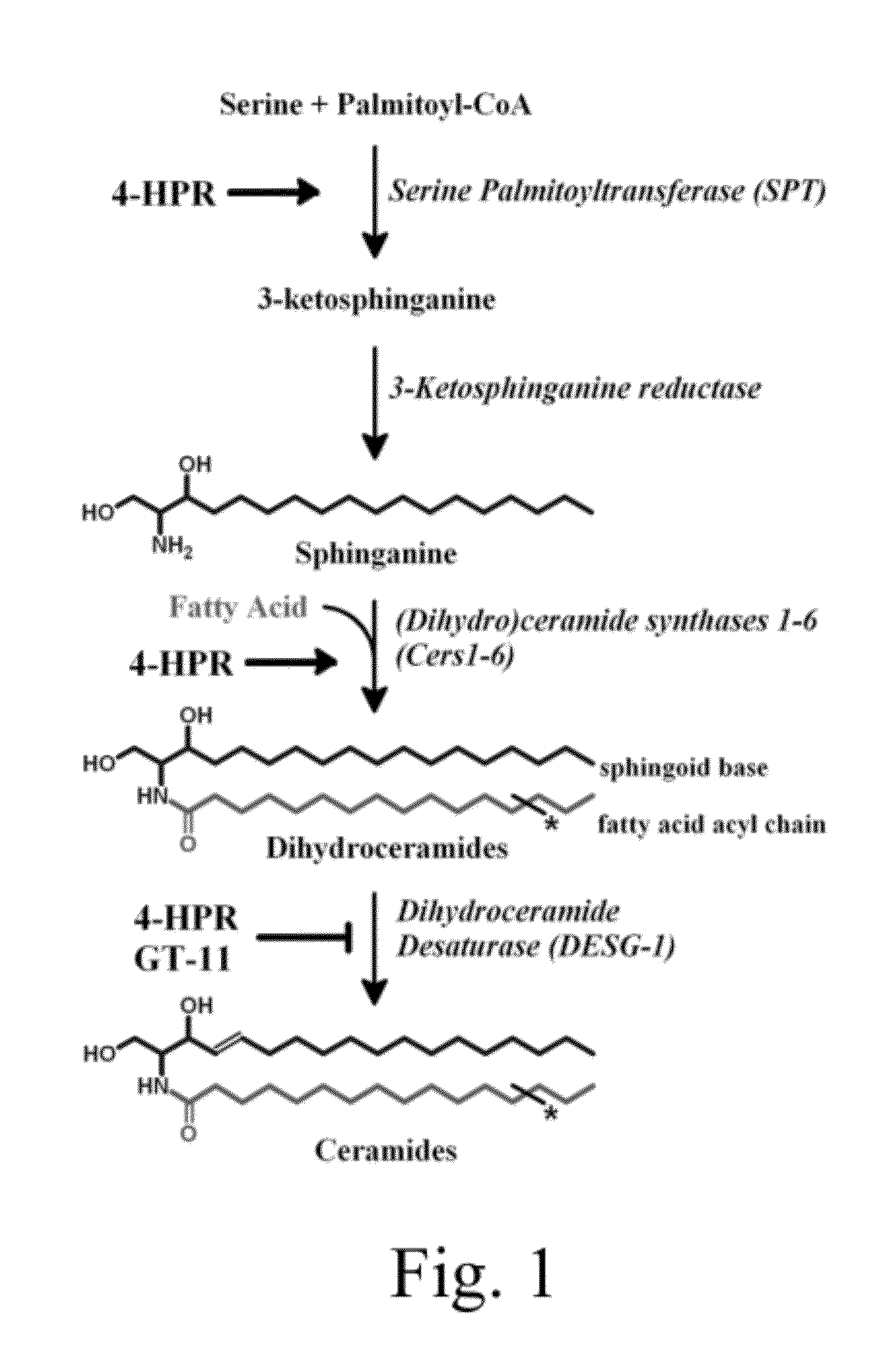Method for Increasing the Production of a Specific ACYL-Chain Dihydroceramide(s) for Improving the Effectiveness of Cancer Treatments
a technology of acyl-chain dihydroceramide and specific acyl-chain dihydroceramide, which is applied in the direction of anhydride/acid/halide active ingredients, biocide, drug compositions, etc., can solve the problems of little known regarding the direct cytotoxic potency of long-chain dihydroceramide, and achieve the effect of increasing the production of specific acyl-chain dihydroceramide(s), improving the effectiveness of cancer treatment, and reducing the cytotoxi
- Summary
- Abstract
- Description
- Claims
- Application Information
AI Technical Summary
Benefits of technology
Problems solved by technology
Method used
Image
Examples
example 1
Pathway of De Novo Dihydroceramide Synthesis
[0030]FIG. 1 shows a schematic of the de novo sphingolipid pathway. Rate-limiting enzyme serine palmitoyltransferase (SPT) condenses serine and palmitoyl-CoA to 3-ketosphinganine, which is subsequently reduced to sphinganine (the ‘sphingoid base’ or ‘sphingoid backbone’). (Dihydro)ceramide synthases (CerS 1-6) selectively N-acylate sphinganine with a fatty acid acyl-chain that may vary in carbon length and degree of saturation, producing a dihydroceramide. Dihydroceramide desaturase (DEGS-1) desaturates the sphingoid backbone of the dihydroceramide to yield the corresponding ceramide. Fenretinide (4-HPR) is a stimulator of both SPT and CerS. Both 4-HPR and GT-11, a synthetic ceramide derivative, are partial inhibitor of DEGS-1. * denotes variable fatty acyl-chain.
example 2
[0031]Materials. Sphinganine [(2S,3R)-2-aminooctadecane-1,3-diol] (Sa) and N-[(1R,2S)-2-hydroxy-1-hydroxymethyl-1-2-(2-tridecyl-1-cyclopropenyl)ethyl]octanamide] (GT-11) were purchased from Avanti Polar Lipids and prepared in ethanol at 10 mM and 1 mM, respectively. Fenretinide [(2E,4E,6E,8E)-N-(4-hydroxyphenyl)-3,7-dimethyl-9-(2,6,6-trimethyl-cyclohexen-1-yl)nona-2,4,6,8-tetraenamide] (4-HPR), was from the National Cancer Institute (NCI) Developmental Therapeutics Program (DTP) of the National Institutes of Health (NIH), and prepared in ethanol (10 mM). Stocks were stored in sealed polypropylene tubes. Fatty acids (Fisher Scientific) were dissolved in solution of methanol / chloroform (1:2, v:v) at 10 mM and stored in PFTE-capped borosilicate vials. Ethanol (200 proof), chloroform (ethanol-stabilized), and other solvents were obtained from Sigma Aldrich or Fisher Scientific. LC / MS / MS solvents were mass spectroscopy grade or higher. Alpha-cyclodextrin (Acros Organics...
example 3
[0036]LC / MS / MS analysis of intracellular sphingolipids. Sphingolipids were separated using an Agilent 1200 HPLC (LC) and determined by ESI / MS / MS performed on a AB SCIEX 4000 QTRAP Hybrid Triple Quadrupole / Linear Ion Trap mass spectrometer (MS), operating in a multiple reaction monitoring positive ionization mode as described previously with moderate modifications (25). Briefly, 50 μL of a solution (1 μM) of internal sphingolipid standards (including -sphingosine, -sphinganine, -sphingosine-1-phosphate, and -ceramide) was added to each cell pellet sample. Lipids of each sample were extracted twice with 2 mL of the ethyl acetate / isopropyl alcohol / water (60:28:12; v:v) solvent system. Supernatants were transferred to glass tubes (Kimble Chase) and evaporated under air (10 PSI) at 40° C. After reconstitution in methanol (4 mL), 1 ml of each sample was separated for the determination of lipid phosphate. Remaining sample (3 mL) was dried and used for sphingolipid quantif...
PUM
| Property | Measurement | Unit |
|---|---|---|
| concentration | aaaaa | aaaaa |
| particle size | aaaaa | aaaaa |
| chain length | aaaaa | aaaaa |
Abstract
Description
Claims
Application Information
 Login to View More
Login to View More - R&D
- Intellectual Property
- Life Sciences
- Materials
- Tech Scout
- Unparalleled Data Quality
- Higher Quality Content
- 60% Fewer Hallucinations
Browse by: Latest US Patents, China's latest patents, Technical Efficacy Thesaurus, Application Domain, Technology Topic, Popular Technical Reports.
© 2025 PatSnap. All rights reserved.Legal|Privacy policy|Modern Slavery Act Transparency Statement|Sitemap|About US| Contact US: help@patsnap.com



